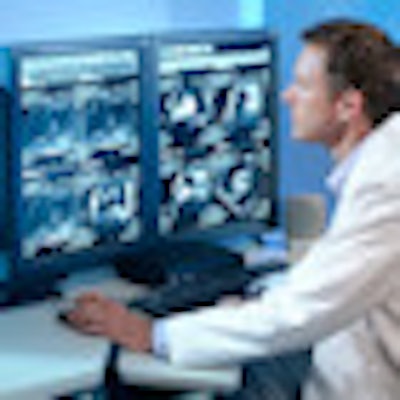
What do members of the European Society of Radiology (ESR) think about teleradiology? In the fall of 2011, several hundred were motivated to offer their opinions. They participated in an Internet survey, the full findings from which have been published online on 18 December by Insights into Imaging.
A total of 386 radiology professionals, the majority of whom were radiologists (71%) but also included radiology residents (14%) and department managers (6%), voluntarily answered 32 multiple choice questions on demographics, types of services used and their capabilities, and perceived advantages, disadvantages, threats, and opportunities of teleradiology services. They also were asked to answer open questions about the current and future role of teleradiology in Europe.
Composition of voluntary survey respondents
 Nearly half of survey participants use teleradiology to receive images at their homes when on-call, according to lead author Dr. Erik Ranschaert.
Nearly half of survey participants use teleradiology to receive images at their homes when on-call, according to lead author Dr. Erik Ranschaert.
Participants of 35 countries responded, but half of the respondents worked in one of four countries: Austria (22%), Belgium (22%), the U.K. (7%), and the Netherlands (6%). The majority worked at university (36%) or public (38%) hospitals. Nearly 20% worked at a private hospital (17%) or a private diagnostic center (11%). Thirteen percent of radiologists also said they were affiliated with a private practice. Five percent worked for a company providing teleradiology services.
There was much more equal representation with respect to radiology group size. Thirty percent worked in large groups with more than 20 radiologists. There was a 22% representation of mid-sized groups of 10 to 20 radiologists. The largest group represented was small radiology groups with fewer than 10 radiologists, at 41%.
Of the total survey respondents, 65% stated that they used teleradiology technology.
Teleradiology utilization
In North America, access to exams by radiology departments in geographically separated facilities affiliated with the same healthcare enterprise is considered to be a function of an enterprise PACS. Another important PACS function is efficient distribution of workload; so also is distribution of specific exams to specialized radiology consultants who may interpret exams acquired at different facilities.
However, the survey participants considered both of these functions to be teleradiology. Almost three-quarters (71%) of the 203 individuals who answered this question stated their primary use was for in-house image distribution and cross-enterprise worklist sharing. Images are transmitted on a hospital enterprise network or a regional network.
While access to a RIS tends to be presumed when images are distributed on an enterprise PACS network, only 54% of respondents reported that they could access the RIS. Only 43% reported they could incorporate the reports they prepared remotely into the RIS. Email was used to send results by 37%.
Half stated they had access to a hospital information system (HIS) to get patient information, and 26% reported they had access to electronic patient records. Use of fax machines (24%) also was reported, as was obtaining information about a patient by talking on the telephone with a department colleague (30%).
In addition, 44% used teleradiology to receive images at their homes when on-call nights and weekends. Slightly more than one-third used teleradiology to outsource images to obtain second opinions from experts (41%) and/or to provide night coverage (40%). Outsourcing images was also reported by 19% to provide temporary support, covering vacancies caused by vacations, illness, or a temporary staff shortage. However, many respondents expressed concern that teleradiology outsourcing available at the time did not provide sufficient access to clinical information and/or relevant prior exams needed for clinical comparison with the outsourced study.
The types of images outsourced included routine cross-sectional exams (57%), radiographs (32%), and exams ordered by emergency departments (31%). Providers of teleradiology services reported they provided primary (77%) and subspecialty (51%) readings, primarily to affiliated hospitals or hospitals within the region.
Opinions
A portion of the survey addressed perceived advantages and disadvantages of teleradiology, offering a list of these to rate. Lead author Dr. Erik Ranschaert, staff radiologist at the Jeroen Bosch Ziekenhuis, teaching hospital in 's-Hertogenbosch, the Netherlands, reported that the opportunity to collaborate with peers was the most valuable aspect of image access, followed by the ability to more efficiently distribute exam interpretation workload.
The key advantages cited of using teleradiology in an outsourcing capacity was being able to obtain a second opinion and/or expert advice from a specialist, followed by having greater ability of radiologists to provide on-call services as needed. However, the usual concerns about adopting teleradiology were cited. These included fear of losing control, creating instability in the job market and in radiologists income, and concern about the quality of the reports created. Nearly half said they perceived teleradiology outsourcing as a threat to providing good patient care.
The future of teleradiology
As might be expected by individuals who voluntarily agreed to spend time answering a questionnaire about a technology, the vast majority (80%) had a positive vision regarding teleradiology's future. They said the current shortage of radiologists and the need for more subspecialization are the principal reasons for the continued need for teleradiology in the future. Many cited the desire to efficiently obtain a second opinion, noting that enhanced collaboration among peers would be very beneficial.
One of the limitations of obtaining a second opinion is remuneration. A specific reimbursement system for teleradiology services, both for patients and for radiologists is needed, the authors wrote. They pointed out that a major factor inhibiting cross-border teleradiology services in Europe is the differences in healthcare systems within countries. Most countries do not regulate the reimbursement of second opinions.
"In order to promote nationwide collaboration among radiologists, it would be desirable to create and make use of a uniform platform facilitating automated invoicing among all parties. ... This would be an incentive to intensify collaboration, improving the overall quality of radiology services in the context of an increasing need for subspecialty advice," they concluded.
As the linkage of healthcare facilities continues, if infrastructure issues such as access to patient records and establishing strong security/privacy protections are resolved, and if payment issues can be overcome, teleradiology will be a vital backbone for improved diagnostic services through collaboration. Virtual radiology practices might even be established.
Additional comments
The authors make a point of advising that their survey represents the unverifiable statements of 368 individuals. Survey findings could have been radically different if others and more of the tens of thousands of ESR members had opted to participate. The authors recommended that large-scale studies be undertaken with a more geographically diverse and representative sample of participants.
While noting that the adoption of teleradiology in Europe has been much slower than in Canada and the U.S., the authors stated that as PACS continues to be adopted, the road for teleradiology is being paved in Europe. The ability to transfer radiology images has stimulated adoption of telemedicine, and that movement will also reinforce teleradiology utilization.
"But for a European collaborative teleradiology model to succeed, the most crucial challenges are implementation of a solid quality assurance system, seamless integration with electronic patient records, solutions to assure the quality and increase the value of radiology reports, and solutions to improve communication with referring clinicians," they concluded.


















